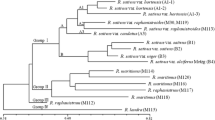Abstract
A survey of 480 10-mer primers for RAPD markers revealed general consistency in primer amplification strength among the flowering plant generaDatisca, Helianthus andYucca. Six characteristics of primer base sequences were analyzed: total (G+C) content; the amounts of G, A, C, and T taken separately; and the (G+C) content in the last four bases of the 3′ end. Of these, total (G+C) content showed the most value in predicting primer amplification strength. Since the consistency of amplification strength is true only globally, there are still many primers showing high variation in amplification strength among genera, most probably due to DNA sequence differences, but perhaps also resulting from experimental artifact. Nevertheless, we suggest that this survey be used as a rough guide for prioritizing primer deployment in RAPD studies involving plants in the hope of improving efficiency during the search for adequate levels of polymorphism, with the understanding that taxon-specific differences in primer amplification strength are bound to occur.
Similar content being viewed by others
Abbreviations
- RAPD:
-
random amplified polymorphic DNA
- CTAB:
-
hexadecyltrimethylammonium bromide
References
Arnold, M.L., C.M. Buckner and J.J. Robinson. 1990. Pollen-mediated introgression and hybrid speciation in Louisiana irises. Proc. Natl. Acad. Sci. 88: 1398–1402.
Doyle, J.J. and J.L. Doyle. 1987. A rapid DNA isolation procedure for small amounts of fresh leaf tissue. Phytochem. Bull. 19:11–15.
Fritsch, P. and L.H. Rieseberg. 1992. Outcrossing rates are high in androdioecious populations of the flowering plantDatisca glomerata. Nature 359:633–636.
Giovannoni, J.J., R.A. Wing, M.W. Ganal and S.D. Tanksley. 1991. Isolation of molecular markers from specific chromosomal intervals using DNA pools from existing mapping populations. Nucleic Acids Res. 19:6553–6558.
Klein-Lankhorst, P.M., A. Vermunt, T. Liharska and P. Zabel. 1991. Isolation of molecular markers for tomato (L. esculentum) using random amplified polymorphic DNA (RAPD). Theor. Appl. Genet. 83:108–114.
Martin, G.B., Williams, J.G.K. and S.D. Tanksley. 1991. Rapid identification of markers linked to aPseudomonas resistance gene in tomato by using random primers and near isogenic lines. Proc. Natl. Acad. Sci. 88:2336–2340.
Michelmore, R.W., I. Paran and R.V. Kesseli. 1991. Identification of markers linked to disease-resistance genes by bulked segregant analysis: a rapid method to detect markers in specific genomic regions by using segregating populations. Proc. Natl. Acad. Sci. 88:9828–9832.
Mulcahy, D.L., N.F. Weeden, R. Kesseli and S.B. Carroll. 1992. DNA probes for the Y-chromosome ofSilene latifolia, a dioecious angiosperm. Sex. Plant Reporod. 5:86–88.
Paran, I., R. Kesseli and R. Michelmore. 1991. Identification of restriction fragment length polymorphism and random amplified polymorphic DNA markers linked to downy mildew resistance genes in lettuce, using near-isogenic lines. Genome 34:1021–1027.
Quiros, C.F., J. Hu, P. This, A.M. Chevre and M. Delseny. 1991. Development and chromosomal localization of genome-specific markers by polymerase chain reaction inBrassica. Theor. Appl. Genet. 82:627–632.
Reiter, R.S., J.G.K. Williams, K.A. Feldmann, J.A. Rafalski, S.V. Tingey and P.A. Scolnik. 1992. Global and local genome mapping inArabidopsis thaliana by using recombinant inbred lines and random amplified polymorphic DNAs. Proc. Natl. Acad. Sci. 89:1477–1481.
Rieseberg, L.H., H. Choi, R. Chan and C.D. Spore. 1992. Genomic map of a diploid hybrid species. Heredity (in press).
Smith, M.L., J.N. Bruhn and J.B. Anderson. 1992. The fungusArmillaria bulbosa is among the largest and oldest living organisms. Nature 356:428–431.
Welsh, J. and M. McClelland. 1990. Fingerprinting genomes using PCR with arbitrary primers. Nucleic Acids Res. 18:7213–7218.
Welsh, J., R.J. Honeycutt, M. McClelland and B.W.S. Sobral. 1991. Parentage determination in maize hybrids using the arbitrarily primed polymerase chain reaction (AP-PCR). Theor. Appl. Genet. 82:473–476.
Wilde, J., R. Waugh and W. Powell. 1992. Genetic fingerprinting ofTheobroma clones using randomly amplified polymorphic DNA markers. Theor. Appl. Genet. 83:871–877.
Williams, J.K.G., A.R. Kubelik, K.J. Livak, J.A. Rafalski and S.V. Tingey. 1990. DNA polymorphisms amplified by arbitrary primers are useful as genetic markers. Nucleic Acids Res. 18:6531–6535.
Author information
Authors and Affiliations
Rights and permissions
About this article
Cite this article
Fritsch, P., Hanson, M.A., Spore, C.D. et al. Constancy of RAPD primer amplification strength among distantly related taxa of flowering plants. Plant Mol Biol Rep 11, 10–20 (1993). https://doi.org/10.1007/BF02670555
Issue Date:
DOI: https://doi.org/10.1007/BF02670555




